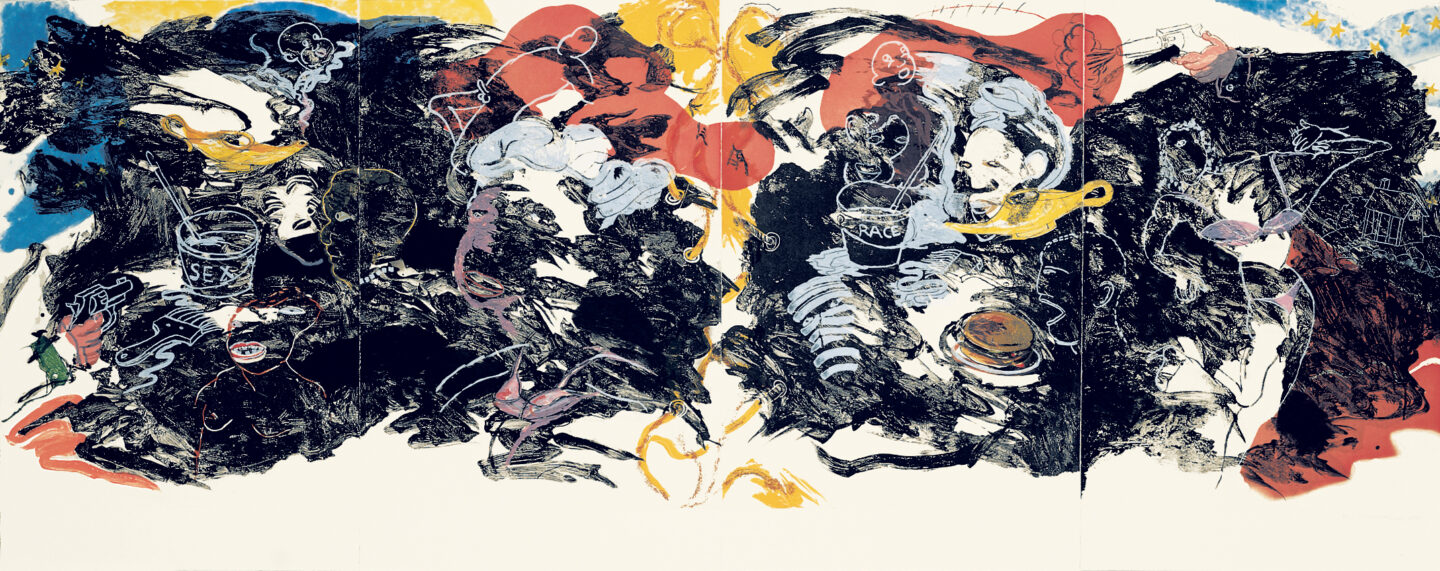Robert Colescott
I spent a couple of years in Egypt and was influenced by the narrative form of Egyptian art, by 3,000 years of a ‘non-white’ art tradition...I think that excited me about some of the ideas about race and culture in our own culture; I wanted to say something about it.
“The most interesting thing about Robert Colescott is that he paints beautifully. Everything else that is interesting about him is interesting in relation to that beautifulness,” wrote Peter Schjeldahl in the Village Voice in 1998. Colescott was born in Oakland, California, in 1925 and died in 2009 . His father was a jazz musician and a friend of the Harlem Renaissance sculptor Sargent Johnson. When Colescott was a boy, he saw Diego Rivera on a scaffold painting a mural in San Francisco. He said, “I could sense the strength in it, even as an eleven-year-old kid. The longer I am around, the more important he looms in my work.”
Colescott fought in France in World War II and returned home to earn a BA and an MA at the University of California, Berkeley. Between 1949 and 1950 he studied in Paris with Fernand Léger. He returned to the United States and taught school in the Pacific Northwest for fourteen years, continuing his painting at the same time. In 1964 he won a fellowship to study at the American Research Center in Cairo. He described his time in Egypt as formative in an interview with Michael Lobel for Artforum. “I spent a couple of years in Egypt and was influenced by the narrative form of Egyptian art, by 3,000 years of a ‘non-white’ art tradition, and by living in a culture that is strictly ‘non-white.’ I think that excited me about some of the ideas about race and culture in our own culture; I wanted to say something about it.”
In 1975 Colescott began a series of paintings that recast the classics of Western art with black characters, including George Washington Carver Crossing the Delaware: Page From an American History Textbook, and Eat Dem Taters, a reworking of van Gogh’s Potato Eaters. In 1976 he received a National Endowment for the Arts grant, with two more to come in 1980 and 1983. In 1985 he was honored with a Guggenheim Fellowship.
In 1987 he had the first of many solo shows at Phyllis Kind Gallery in New York. In 1987 the exhibition Robert Colescott: A Retrospective, 1975–1986 originated at the San Jose Museum of Art in California and traveled to the New Museum of Contemporary Art in New York, among other venues. In 1997 Colescott was chosen to represent the United States at the Venice Biennale. That same year he completed Pontchartrain, a monumental etching ten feet long, at Crown Point Press. In 2019, the comprehensive retrospective Art and Race Matters: The Career of Robert Colescott opened at the Contemporary Arts Center in Cincinnati, OH, and traveled to Portland Art Museum, Portland, OR (February 15–December 13, 2020).
Colescott’s work is held in many public collections in the United States, including the Museum of Fine Arts, Boston; the Fabric Workshop and Museum, Philadelphia; the San Francisco Museum of Modern Art; and the Corcoran Gallery of Art, Washington, DC. The artist’s estate is represented by the gallery Blum & Poe located in Los Angeles, New York, and Tokyo.
-Kim Bennett, Crown Point Press
